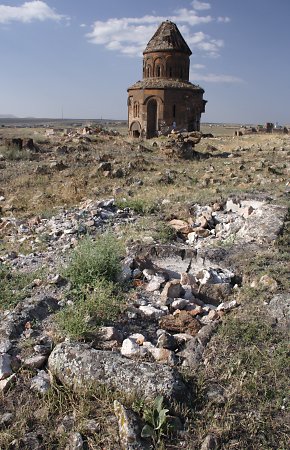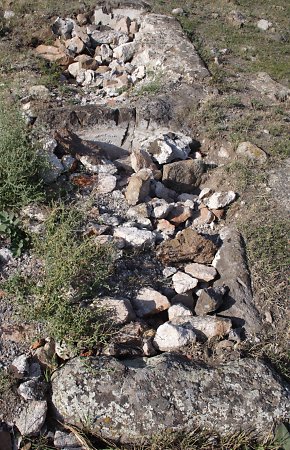|
Archive for the 'Cultural Genocide' Category
Simon Maghakyan on 13 Jan 2008
Exactly three years after Azg published the English translation of an article I wrote about the distortion of an Armenian song commemorating the 1909 Adana massacre by the Young Turks, I came across to the “Turkish version” of the song on YouTube which reminded me of a more recent attempt by a Turkish artist to promote reconciliation between Armenians and Turks by distorting Armenian history that I blogged on a few days ago.
It seems pretty sick that reconciliation of two neighbors can only be done by deliberatly “integrating” Turkish versions to Armenian history. But vandalism is not only limited to the Armenian-Turkish case.
I am reading Australian journalist Robert Bevan’s The Destruction of Memory: Architecture at Warand finding out how the world is similar – when it comes to treating the cultural monuments of the “other” for instance. Only a few years back, in March of 2004, “a mob of young Serbs set fire to the historic Islam-aga mosque in Nis, Serbaia. The attach, and one on the Bayrakli mosque in Belgrade, were a response to the destruction of dozens of Orthodox churches and monasteries in Kosovo by Kosovar nationalists the day before.”
I follow international news as much as possible but I don’t recall reports of the March 2004 destruction of mosques and churches in former Yugoslavia. Why is the world so silent about cultural vandalism?
Simon Maghakyan on 12 Jan 2008
It is time for Armenian-American organizations to check with all the U.S. presidential candidates about their views on Armenian issues. Some things can be negotiated but one thing cannot.
No, not the genocide resolution but Section 907 – the ban of U.S. assistance to Azerbaijan that G.W. Bush has been waiving since 2001.
According to Wikipedia:
Section 907 of the United States Freedom Support Act bans any kind of direct United States aid to the Azerbaijani government. This ban makes Azerbaijan the only exception to the countries of the former Soviet Union, to receive direct aid from United States government under the Freedom Support Act to facilitate economic and political stability.[1].
The Act was strongly lobbied for by the Armenian American community in the US[2], and was passed in response to Azerbaijan’s blockade of Armenia. which was at full scale war with Azerbaijan over the predominantly Armenian populated Nagorno Karabakhregion of Azerbaijan. Since 1994 cease-fire agreement Nagorno Karabakh has established a de-facto independent republic, which is not recognized by any country.
On October 24, 2001, the Senate adopted a waiver of section 907 that would provide the President with ability to waiver the Section 07[3]. He has done so since then.
In a sense, American taxpayers have paid for the destruction of the largest medieval Armenian cemetery in the world. The destruction of old Djulfa in December of 2005 was carried out by soldiers of the Azerbaijani army, as seen in film, using heavy technology. This is the same army that the current American administration has been giving money since October of 2001.
Thus, the question posed to all U.S. presidential candidates should be:
Dear candidate, in December of 2005 Azerbaijan’s army reduced to dust world’s largest medieval Armenian cemetery. Since 2001, the current administration has been waiving Section 907 of the Freedom Support Act, legislation that bans military aid to the Republic of Azerbaijan. If elected a president, will you or will you not waive Section 907?
Simon Maghakyan on 08 Jan 2008
The current issue of The Armenian Reporter (January 5, 2008), a newspaper in the United States, has my latest article on the destruction of the Djulfa cemetery discussing the politically safe “both sides are guilty” argument and its effectiveness.
The article, with a front page preview, also features a satellite image from the Djulfa cemetery before its final destruction showing marks of pre-2003 destruction. To see the satellite image and the article in the actual paper format, download the January 5, 2008 issue of The Armenian Reporter from http://mark.armenianreporteronline.com/generating/pdf/2008/jan05/A0105.pdf.
The full article is also available at the Djulfa blog.
[…]
While on a one-day visit to Nakhichevan last November, the U.S. Ambassador in AzerbaijanAnne Derse was confronted by angry Azeri students who were unhappy that an exhibit at Harvard Universityfeatured photographs of Armenian cultural heritage – today completely vanished – in Nakhichevan. During Mrs. Derse’s visit, the Nakhichevani branch of Azerbaijan’s National Academy of Sciences issued an official statement proclaiming that “there is no Armenian historical or cultural monument among those registered” in the region.
In fact, these Armenian monuments no longer exist. One of the largest – the medieval cemetery of Djulfa – was wiped off the face of the earth two years ago, in December 2005, in a well-documented case of vandalism that was condemned by the European Union.
And according to what Jonathan Henick, Public Affairs Officer at the American Embassy in Baku, told this writer, “[t]he Ambassador and others at the Embassy have raised the issue of the Djulfa cemetery with Azerbaijani officials.”
But during her short visit to Nakhichevan, Mr. Henick said, “The Ambassador did not have the opportunity to travel outside of the capital city. She did visit a number of interesting cultural monuments in Nakhichivan city, but our understanding is that none of those monuments were of Armenian origin.”
Perhaps the Ambassador missed a chance to visit the site where the world’s largest Armenian cemetery existed not too long ago. Instead, the American Embassy, as articulated by Mr. Henick, offered an important message to Armenia and Azerbaijan that “joint efforts to preserve monuments in both countries would serve the interests of safeguarding the shared cultural heritage of this fascinating region and might also be a valuable confidence- building measure in the ongoing efforts to find a peaceful resolution to the Nagorno Karabakh conflict.”
The well-intentioned statement of the Embassy resonates with a popular Western sentiment that “both sides are to blame” for the cultural destruction that is happening. This argument is in a way a form of political correctness and seeks not to dehumanize any ethnic group.
Yet this approach avoids analysis of specific cases and unintentionally supports the prejudiced “barbarian” argument – “Azeris are barbarians they have always destroyed Armenian monuments,” and vice versa. It suggests that if we accept that a certain aspect of an ethnic conflict – such as destroying the other’s culture – may be an official policy or a norm among one side and not necessarily and equally among the other then this one side is more “civilized” than the other.
In reality, cultural destruction during ethnic conflict and who destroys how much and how it goes about destroying is not a reflection of “clash of civilizations,” but a representation of a slew of historical and social circumstances. These do not demonstrate the “humanity” of one people or another but whether one or the other perceives the opposite side as much human.
[…]
Armenia’s leaders have no such reasons to rewrite history and instead try to contrast their policies to what Azerbaijanhas done to Armenian monuments. The restoration of two mosques in Karabakh with government funding is the most recent such example.
A more realistic picture of Azeri monuments in Armeniais one of neglect and ignorance, as Vanadzor-based journalist Naira Bulgadarian reported for the IWPR Caucasus Report in September 2007. There is also an effort to present Muslim monuments on Armenian territory as belonging only to the Persians, and not the Azeris – while both groups, as well as Kurds, Turkmen and Arabs, can lay claims to these monuments.
Yet, as Ms. Bulgadarian reported, the Armenian government has also allocated funds to catalogue and to safeguard Azeri cemeteries. An exhibit in Stepanakert late last year featured photographs of about 30 Muslim monuments in Karabakh.
Azerbaijani officials and activists, on the other hand, have to a large degree ridiculed the discussion of monuments in the South Caucasus. Last October and November, as part of the effort to thwart the Nakhichevan exhibit at Harvard, the Azerbaijani Foreign Ministry distributed letters and statements claiming that “Armenians destroyed over 100,000 cultural monuments, hundreds of cemeteries and 1,000-2,000-year-old archaeological monuments in the occupied Azerbaijani territory.”[…]
Simon Maghakyan on 10 Nov 2007
An interesting article in ArmeniaNow reveals two interesting things on cultural property in the South Caucasus – governments are highly involved in both protection and destruction.
For one, the article says, Armenia has welcomed European observers to monitor Azeri monuments on Armenian territory regardless whether Azerbaijan (which has twice denied such monitoring) agrees monitoring of Armenian monuments on its territory or not.
The news that the government of Armenia has given its consent to the European observers to carry out a monitoring on the state of cultural monuments on the territory of the republic, regardless of the official Baku’s standpoint on receiving such group of experts, caused an ambiguous reaction in Armenia. It should be noted that the Secretary General of the Council of Europe Terry Davis declared this during his visit to Yerevan on November 5. Commenting on the news, he stressed that such position is in the country’s interests as it can have a positive impact on its international image.
This has invited criticism by those who think Armenia needs to improve civil rights and not “show off” that it is not destroying Azeri monuments as a means of promoting itself as a democratic country.
“Does the Council of Europe have the right to judge Armenia’s image not from the view of adhering civil freedoms, but of the declared interest in preservation of the Armenian nation’s cultural heritage?” wonders a well-known art critic, the Head of Avan’s Museum of History and Archeology Ara Demirkhanyan.
The ArmeniaNow article also shows a possible link between the destruction of world’s largest Armenian cemetery in Azerbaijan (reportedly destroyed in 1998, 2003 and finalized in 2005) and the now-deceased former Azerbaijani president Heydar Aliyev, who was succeeded by his son. It is not ruled out that the order was central, concludes an interviewee.
It’s noteworthy that it was in that period when a special archeological expedition started operating on the territory of Nakhijevan. “It [the expedition] was called by a direct order of Heidar Aliyev in 2001,” says the Deputy Head (on scientific issues) of Azerbaijan’s National Academy of Sciences’ Institute of Archeology and Ethnography Najaf Musiebli. “That expedition continued its work up to 2003. During the three years large-scale field works were held on the territory of Nakhijevan aimed at revealing historical monuments so far unknown to science. As a result of archeological excavations monuments of ancient settlements were discovered.”
“It’s quite possible that the given archeological party, besides other things, was engaged in making an ‘inventory’ of Armenian monuments that were subject to extermination. This is indirectly confirmed by the timing of its activity,” Demirkhanyan says.
Musiebli’s recently published (November 5) statement in this connection is worth mentioning here: “We have to say that the expedition was not organized by chance. Constant disinformation of the world community by the Armenians that the territory of Nakhijevan is also an ancient Armenian land forced the state to call a scientific-research expedition and as a result of numerous archaeological facts the false propaganda of the occupants was proved.”
Simon Maghakyan on 23 Oct 2007
Disturbing photographs and documentation of recent desecrations in Ani, western Armenia, as observed by Steven Sim.
Source: http://www.virtualani.org/2007/index.htm
DAMAGE TO ANI BETWEEN 2006 AND 2007
Those Employed to Guard Ani are Destroying Ani
During the 1980s and 1990s, when the whole site of Ani was under the full control of the Turkish Army, very little damage was done to the remains as a result of the activities of treasure hunters. This was in marked contrast to most other archaeological sites in Turkey.
In 2004, as a result of a decision made by the Turkish Ministry of Defence, the responsibility for the day-to-day control of the Ani archaeological site was passed from the Turkish Army to the Turkish Ministry of Culture. The immediate effect of this was that it was now possible to travel to Ani without needing a permit, photography within the site was now permitted, and only a token number of soldiers would now patrol the site.
Part of the conditions set by the Turkish army before allowing this hand-over was that civilian guards had to be appointed to supervise the site and replace the duties previously performed by the soldiers. These guards are not actually employees of the Ministry of Culture because the task of guarding Ani was subcontracted to a Kars-based business.
All the guards are inhabitants of Ocakli village, located just outside Ani’s walls. At night they use their position of authority to roam the ruins at will, digging anywhere they think may contain treasure. The following photographs document some of the damage they have done. All of this destruction took place between August 2006 and August 2007.
Photographic Evidence
It is probable that considerably more damage has been done to the remains than is depicted here. In many cases the evidence is located in little-visited parts of Ani and would be be noticeable when actually walked over.
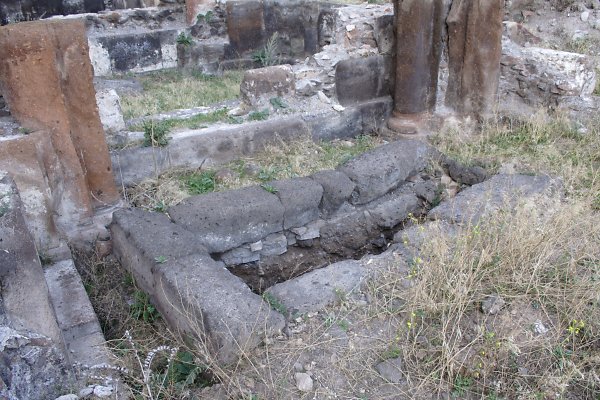
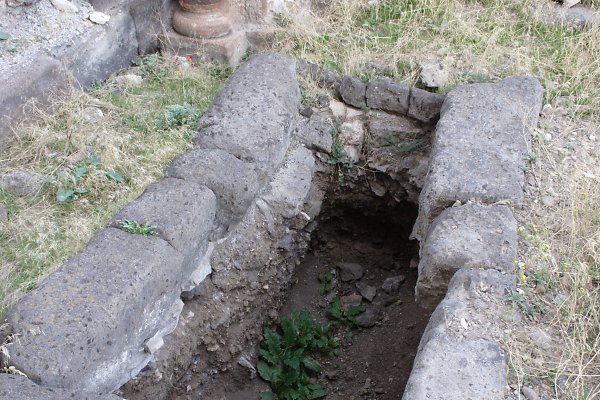
In 2002 and 2003, French archaeologists from the Sorbonne excavated a series of structures located beside the west façade of the cathedral. A row of three chambers was uncovered. At the southern end of the row is a chamber open to the south. Inside it is a grave that may have been that of Queen Katranide who had the cathedral completed. The archaeologists excavated the contents of the grave, but no human remains were found. Treasure hunters have now dug out the entire contents of the grave.
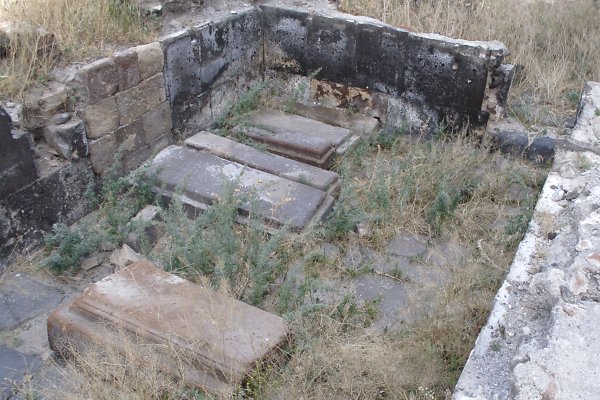
To the north of the Katranide tomb is a small chapel, then there is a rectangular chamber that contains a row of six gravestones, two of which have inscriptions on them. Because of the significance of the location, in the shadow of the cathedral, it is probable that only Ani’s most important personages would have been interred there. The above photograph shows the chamber in 2006.
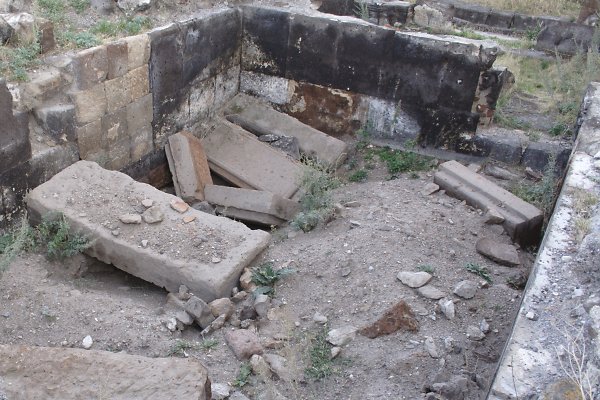
The above photograph shows the same view in 2007.
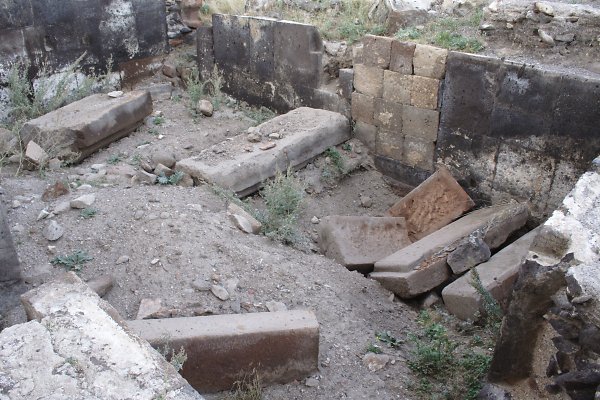
The broken gravestone and the upturned gravestone were the two stones that had inscriptions in Armenian on them.
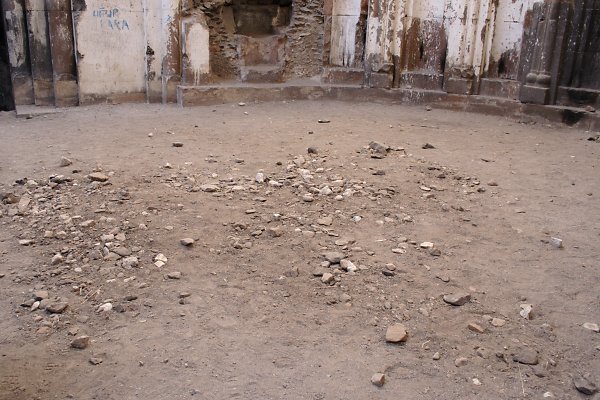
On the floor of the apse of the cathedral, an area of disturbed ground indicates the spot where the Ani guards had dug a large hole in their quest for treasure.
The photographs above show a series of sarcophagus-like structures, almost certainly graves, located near the Church of St. Gregory of the Abughamirs. Between 2006 and 2007 their contents were dug out, then roughly filled in again.
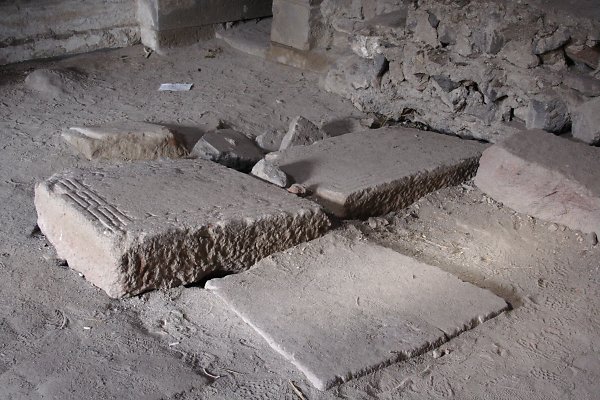
This photograph was taken inside the Church of Tigran Honents. Several large gravestones set into the floor in front of the apse have been moved and the ground beneath them has been dug up.
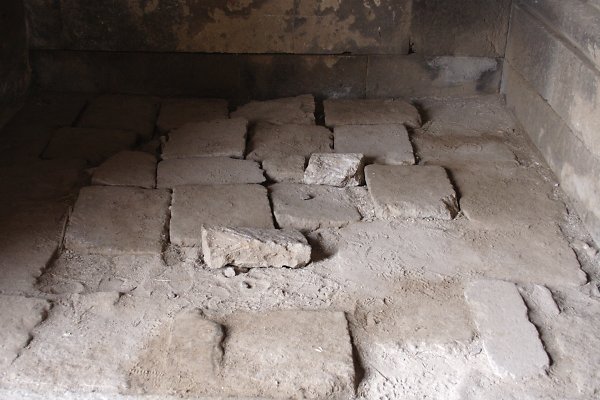
Inside the north-west corner of the Tigran Honents church. The medieval floor paving has been pulled up to allow the digging of a hole, and has then been roughly re-laid.
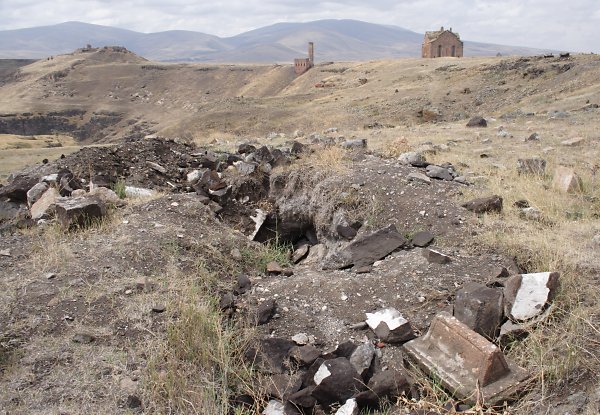
This part of Ani is located to the east of the cathedral and overlooks the Tigran Honents church. It contains the site of a medieval cemetery. Several of the graves have been dug up, and gravestones and capping slabs have been broken.
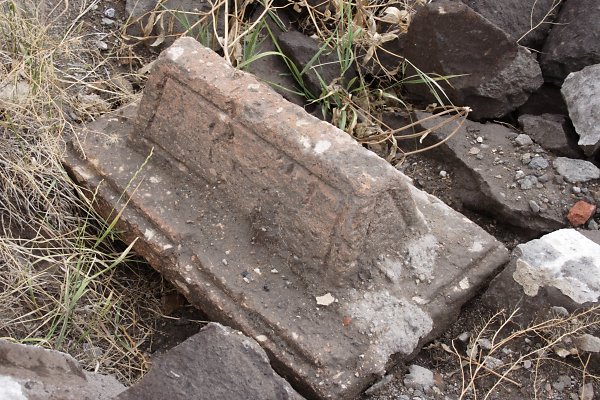
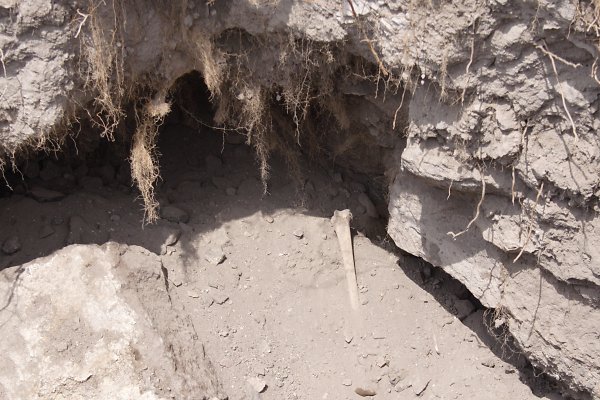
Human bones are visible inside one of the desecrated graves.
Simon Maghakyan on 18 Oct 2007
History Today, world’s premier and perhaps oldest history magazine, has my article about the Djulfa destruction in the November 2007 issue.
The printed magazine, that includes three more photographs, should be available in most western libraries and many bookstores. The online version features the entire article with one photograph, but you have to pay to view the article in full.
When, in the summer of 2005, Scottish researcher Steven Sim visited the region of Nakhichevan, an exclave of the South Caucasus republic of Azerbaijan, in order to study medieval Armenian monuments, he found out his trip was in vain – there was nothing there for him to research. After being detained and questioned by security police, Sim was asked why he expected Armenian Christian churches in a region where only Muslims lived. A villager, too, told him Armenians had never lived in Nakhichevan. When the researcher explained that a book had directed him to the ancient Armenian church in the village, an old man blasted out words in what Sim thought was German. The translator explained that the man was talking to him in Armenian, apparently to see if Sim was an Armenian spy. Knowing Armenian in a place where no Armenians ever lived seemed too awkward.
But Sim did not confront Azeris in Nakhichevan about history. Neither did he resist orders to put his camera away in a military zone at the Azerbaijani-Iranian border when his train was passing by world’s largest surviving Armenian medieval cemetery – Djulfa (Jugha in Armenian). Sim might have done otherwise if he knew back then he was going to be the last known outsider in this remote area – on the border with Iran – to glance at the thousands of sacred and beautifully ….
Simon Maghakyan on 21 Sep 2007
The wipe out of medieval Armenia’s largest cemetery in 2005 by the Azeri authorities has finally brought international attention, at least in media, to the protection of both Armenian and Azeri monuments in the region.
Three articles from this week’s Institute for War & Peace Reporting (IWPR) issue deal with cultural protection in the South Caucasus – from another Armenian cemetery being erased by the Azeri authorities in Baku (that I wrote about in early June of this year); two mosques in Shushi being restored by Armenians to show off they are far from Azerbaijan’s official policy of cultural genocide, and a more realistic situation of Azeri graves neglected in Armenia.
One needs to applaud Azerbaijani-Armenian conflict expert Tom de Waal – an IWPR editor – for his equal concern for Armenian and Azeri monuments.
Although rarely mentioned in these days, the unbelievable destruction of Djulfa has, perhaps, shook off people that cultural heritage protection is not a pr issue but a real concern.
The academic community seems to share the view. The world’s premier, and probably the oldest, history magazine, is interested in documenting cultural destruction. In its upcoming November issue, History Today will feature an article on the Djulfa destruction by this author.
Simon Maghakyan on 01 Jul 2007
This week’s Reporter (June 30, 2007) has my newest article on the destruction of Djulfa cemetery that I just wrote for them using much information from my last semester’s research.
You can download the PDF version of current issue’s Section A – where my piece is – from here.
Here is the article in full:
International Reaction to Djulfa cemetery destruction has been only words and no action
by Simon Maghakyan
June 30, 2007

DENVER, CO. – After several failures to visit Djulfa (Jugha), where the largest medieval Armenian cemetery was reduced to dust by Azerbaijan’s military a year and a half ago, officials at international organizations are talking again about sending experts to the region.
While reports about plans to send a mission by the United Nations Educational, Scientific and Cultural Organization (UNESCO) to Armenia and Azerbaijan have again appeared in the media, words are all that have reached so far the remote shores of the Araxes where an archeological monument with thousands of ancient Armenian burial stones, khachkars, existed not too long ago.
Still a UNESCO spokesperson says their talks are serious and, according to Armenpress, the organization is now working out the details of a visit both to Nakhichevan – where Djulfa is located – and Karabakh, where Azerbaijan alleges Armenians have destroyed Azeri monuments.
And this week, the Armenian Foreign Ministry spokesman Vladimir Karapetian said that UNESCO has already determined the make-up of its monitoring group and that currently the issue is with the visits’ timing.
Armenians and others have long urged UNESCO to interfere in the destruction of the Djulfa cemetery and other Armenian monuments.
In October 2006, an international group of parliamentarians from Canada, France, Greece, the United Kingdom, Russia and Switzerland traveled to UNESCO’s Paris headquarters in order to request that Director-General Koїchiro Matsuura take up an investigation in Djulfa.
Canadian Parliamentarian Jim Karygiannis, a member of the delegation to Paris, this week told this author that he still has not heard back from UNESCO.
***
In addition to UNESCO, the Council of Europe Secretary General Terry Davis has expressed interest in sending experts to monitor cultural sites whenever a relevant agreement with Armenia and Azerbaijan is reached.
But efforts by the European Parliament to send a delegation to Djulfa, headed by British MP Edward O’Hara, first in 2006 and again in April 2007 have been unsuccessful. This was despite the February 16, 2006 European Parliament resolution condemning the destruction of Djulfa and calling on Azerbaijan to allow “a European parliament delegation to visit the archaeological site of Djulfa.”
O’Hara told this author that no party but himself is to blame for this year’s postponement which was “entirely due to domestic commitments.” This explanation is different from last year’s cancellation, which as The Art Newspaper (London) reported in June 2006, was due to Azerbaijan’s refusal to allow ten delegates to enter its territory.
Meantime, there has been no reaction towards claims by Azeri officials and nationalist historians that the cemetery did not exist or was not Armenian. Foreign diplomats and organizations with presence in Baku have also been quiet toward Azerbaijan’s anti-Armenian activities. Former Norwegian Ambassador Steinar Gil, who publicized a case of vandalism at an Armenian church in central Azerbaijan, remains the only exception.
Thomas de Waal, an expert on Armenian-Azerbaijani relations says that “foreign investors and diplomats in Azerbaijan are very sensitive towards anything that touches on the Armenian-Azerbaijani issue and the peace process and are therefore very timid about raising the issue of the destruction of cultural monuments.”
***
Azerbaijan’s continuing military build-up and threats to launch a new war to win control over Nagorno Karabakh add on to the concern for the peace process. But Human Rights Watch has also blamed the West, especially the United States, for trading human rights for oil in Azerbaijan for inaction to condemn broad range of human rights violations.
The U.S. State Department did not react on the Djulfa vandalism until pressed for comment. Following a congressional hearing on February 16, 2006, Secretary of State Condoleezza Rice sent a written response to Rep. Grace Napolitano (D-Calif.) acknowledging U.S. awareness of “allegations of desecration of cultural monuments” and urged Azerbaijan to “take appropriate measures to prevent any desecration of cultural monuments.” She also said the U.S. has “encouraged Armenia and Azerbaijan to work with UNESCO to investigate the incident.”
During a visit to Armenia in March 2006, Deputy Assistant Secretary of State Matt Bryza called the destruction a “tragedy.” He said: “it’s awful what happened in Djulfa. But the United States cannot take steps to stop it as it is happening on foreign soil. We continually raise this issue at meetings with Azeri officials. We are hopeful that the guilty will justly be punished.”
Later that month, Bryza’s State Department manager, Assistant Secretary Dan Fried, told the Armenian Assembly of America conference in Washington that he “would be happy to raise issues of Armenian historical sites” with Azerbaijani officials because respect and protection for cultural sites is “a universal policy of the United States.”
And in her May 12, 2006 response to Sen. Barbara Boxer (D-Calif.), U.S. Ambassador-designate to Azerbaijan Anne Derse noted that the U.S. is “urging the relevant Azerbaijani authorities to investigate the allegations of desecration of cultural monuments in Nakhichevan. If I am confirmed, and if such issues arise during my tenure, I will communicate our concerns to the Government of Azerbaijan and pursue appropriate activities in support of U.S. interests.”
***
The destruction of Djulfa, nonetheless, did not make it into the State Department’s 2006 International Religious Freedom Report on Azerbaijan released on September 15, 2006. The report only repeated the previous years’ language that “all Armenian churches, many of which were damaged in ethnic riots that took place more than a decade ago, remained closed.”
Likewise, the report failed to notice the words of the Norwegian Ambassador that a church in the village of Nizh was in early 2006 “restored” with Armenian lettering eliminated from its walls and nearby tombstones. That “restoration” was part of the Azerbaijan’s effort to present the Armenian cultural heritage on its territory as “Albanian” – that is belonging to a culture that became extinct hundreds of years ago – and therefore not Armenian.
***
The most detailed outsider’s account of Nakhichevan’s Armenian heritage remains that of Steven Sim, a Scottish architect who visited the area in the summer of 2005. During his visit he found no trace of a single medieval Armenian church he had travelled to research, with local interlocutors denying there were any churches there in the first place.
Still, while traveling along the border with Iran, Sim did manage to see the Djulfa khachkars from his train before the hand-crafted stones were erased from the face of the Earth in less than half a year.
More than 350 years ago before Sim’s visit, a foreign traveller to Djulfa had estimated 10,000 khachkars in the cemetery. By 1998, less than seven decades after a Soviet agreement with Turkey placed Nakhichevan under Azerbaijan, there were only 2,000 khachkars remaining while the entire Armenian population had disappeared.
According to eyewitness reports cited by the International Council on Monuments and Sites (ICOMOS), Azeri authorities made efforts to destroy much of the Djulfa cemetery in 1998 and again in 2002. Describing what he saw in Djulfa in August 2005, Sim reported “what I saw was real savageness, but I cannot say that they did not leave anything, since there are still lying khachkars.”
Four months later, on December 15, 2005, Russia’s Regnum News Agency was the first international outlet to quote reports of approximately “100 Azerbaijani servicemen penetrate[ing] the Armenian cemetery near Nakhichevan… using sledgehammers and other tools… to crush Armenian graves and crosses.”
This final stage of destruction, which also amounted to desecration of Armenian remains underneath the burial monuments, had reportedly started on December 14 and lasted for three days, leaving no trace of a single khachkar.
An Armenian film crew in northern Iran, from where the cemetery was visible, had videotaped dozens of men in uniform hacking away at the khachkars with sledgehammers, using a crane to remove some of the largest stones from the ground, breaking the stones into small pieces, and dumping them into the River Araxes using a heavy truck.
Nevertheless, Azeri president Ilham Aliyev told the Associated Press that the reports of the destruction are “an absolute lie, slanderous information, a provocation.”
By March 2006, photographs of the cemetery site showed that it had been turned into an army shooting range. An Azerbaijani journalist who visited the area on behalf of the London-based Institute for War and Peace Reporting in April 2006 similarly found no traces of the cemetery left.
Simon Maghakyan on 07 May 2007
Three international female journalists have been arrested in Nakhichevan after a local villager overheard them talking in Armenian, reports Realni Azerbaijan Russian-language online newspaper on May 5, 2007.

Map of Azerbaijan showing Kangarli rayon
Courtesy of Answers.com
According to the accounts of villagers from Shakhtakhti (region of Kengerli), three journalists from a Russian TV visited Nakhichevan and convinced local villager Aleksper Asadov to guide them to the “Albanian church” of the village for a report on ancient historical monuments.
During videotaping the church, the journalists, according to Aleksper Asadov, started talking in Armenian. Asadov informed the villagers who soon contacted the local police. After the journalists were arrested having left the church, Asadov was instructed by the police to say that the journalists were not Armenian but Russian.
According to Realni Azerbaijan, whose editor was sentenced to 2 ½ years in jail last month after visiting Nagorno Karabakh (a disputed region de facto part of Armenia, de jure part of Azerbaijan) and challenging official’s Azerbaijan’s accusation that Armenian forces killed and mutilated several hundred Azeri civilians of Khojaly during the war of the 1990s, the news about the Armenian journalists has spread all over Nakhichevan. The identities of the three female journalists remain unknown.
Nakhichevan is an exclave of Azerbaijan between Armenia and Iran. According to eyewitness reports, the rich Armenian culture there has been reduced to dust and the few survived Armenian monuments have been proclaimed “Albanian.” The recent act of vandalism against Armenian heritage was the complete destruction of the largest medieval Armenian cemetery on Earth in Southern Nakhichevan’s Djulfa district in December of 2005 that was videotaped and made available on the Internet. European Parliament members were barred by Azerbaijan from visiting the site where the cemetery (now converted to a military rifle range) existed.
The international community has recently accused Azerbaijan for persecuting journalists. Two Azeri journalists were jailed for “insulting Islam” just last week.
Simon Maghakyan on 27 Apr 2007

© Blogian 2007 – Pow Wow Native American Festival in Denver
In July 2006 an Alaska Native woman in Fairbanks reported to the police that she had been raped by a non-Native man. She gave a description of the alleged perpetrator and city police officers told her that they were going to look for him. She waited for the police to return and when they failed to do so, she went to the emergency room for treatment. A support worker told Amnesty International that the woman had bruises all over her body and was so traumatized that she was talking very quickly. She said that, although the woman was not drunk, the Sexual Assault Response Team nevertheless “treated her like a drunk Native woman first and a rape victim second”. The support worker described how the woman was given some painkillers and some money to go to a non-Native shelter, which turned her away because they also assumed that she was drunk: “This is why Native women don’t report. It’s creating a breeding ground for sexual predators.”
The paragraph above is from a study by Amnesty International, released on April 24, 2007, that has concluded, “One in three Native American or Alaska Native women will be raped at some point in their lives. Most do not seek justice because they know they will be met with inaction or indifference.”

© Blogian 2007 – Pow Wow Native American Festival in Denver
According to the report, Native American women are about 3 times more likely to be raped in America than other women. Moreover,
According to the US Department of Justice, in at least 86 per cent of reported cases of rape or sexual assault against American Indian and Alaska Native women, survivors report that the perpetrators are non-Native men. (This is in the case when most rapes in America are perpetrated by the same racial group – Blogian.)
The violation against Native American women is shocking and reminds of all the trouble and suffering that these people have been going through for hundreds of years. Reading Lakota Woman earlier this year – a book by Mary Crow Dog about her experience as a Native American woman – I could not believe that even in the 1970s there was cultural genocide going on against the Natives. But it turns out it is going on today, in 2007.

© Blogian 2007 – Pow Wow Native American Festival in Denver
I think the rape of Native American women is continuation of the cultural genocide. But whatever you name it, it is happening and needs immediate reaction, especially given the Amnesty International charge that the US government is to blame for not protecting these women and children.
Interestingly, I brought similar topic up with my Native American studies professor Glenn Morris two weeks ago when I asked him what was the situation with human trafficking among Native American reservations (having found out about domestic human trafficking in the US, I had figured out that most vulnerable of US communities – the “Indian” reservations – would be a source for violating women and children). Prof. Morris didn’t know whether there was human trafficking, but he said there were lots of rape.
The full study is available at http://web.amnesty.org/library/Index/ENGAMR510352007.
« Previous Page — Next Page »
|
|






